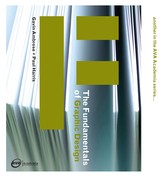
Job No:01077 Title:The fundamentals og Graphic Design
2ND
Proof Page:74
Company profile
The public’s perception of a company, their products or activities. A company’s idea of the public’s view of them is not always the
same as the public’s perception. Therefore, a realigning a company’s profile is sometimes necessary.
74 The Fundamentals of Graphic Design T
he graphic design process
Informal
The second type of brief is informal and is often little
more than a fleeting conversation or telephone call.
In such instances, it is important for the designer to
take notes and ask questions in order to get a clear
understanding of what is required and why. It is good
practice to follow an informal conversation with
a letter or email which can be sent to the client
to confirm that there is a shared understanding
regarding the brief. This also formalises and
solidifies the aims and objectives of the project.
This briefing method allows the designer to tap
into the enthusiasm of the client, which may spark
ideas during the conversation.
Formal
A formal brief is a written document provided to a
designer together with supporting reference material
detailing a clear set of objectives that are to be met
by the design. These criteria can relate to creative
aspirations, aesthetic values, brand development, or
more tangible goals, such as redesigning a website to
convert more hits into sales. The objective could also
be less tangible and harder to measure, such as
raising a c
ompany’s profile.
Whatever the aim, having a formal brief allows all
parties involved to understand what is intended. It
can be referred to during the project to ensure that it
is ‘on brief’, meaning the design is being produced
according to the brief’s requirements.
The brief
The brief is the outline of what a client wants
to achieve by commissioning a design. Armed with
creative thinking tools, personal influences and source
material, a designer can respond to a brief and
generate creative solutions for it. However, it must
be noted that there are two distinct kinds of brief.
072-107 01077_C1.qxd 8/20/08 2:24 PM Page 74

Job No:01077 Title:The fundamentals og Graphic Design
2ND
Proof Page:75
The brief > Articulating design 75
Rewriting the brief
Designers often rewrite a brief received from a client
as doing so allows the design team to ingest the
client’s requirements and restate them in a way that
is more conducive to producing a solution. This may
involve a subtle change in language or a more
profound rethink of the project’s goals. For example, a
client may think they need a new website to increase
sales, but the better solution may be to develop new
marketing material.
A designer’s failure to deliver the intended
results may be due to a poor, vague or misunderstood
brief. Rewriting the brief gives the design team an
opportunity to challenge, clarify and realign the brief
to ensure that it is clear and that the final design
meets the stated goals of the client.
100% Design
This series of posters was created by Blast for the 100% Design
show. The brief required a show concept that was less corporate
than previous years and more appealing to the potential design
exhibitors. In response, Blast produced a strong concept that
resulted in an engaging campaign based on the idea that good
design improves the environment. Using a subtle play on the
conventions of environmental campaigns, the resulting images
acted as a call to action for designers to come together to
improve the environment. The photographer, Sanjay Kalideen,
was briefed to compose dramatic shots that convey the feel of a
fashion shoot.
072-107 01077_C1.qxd 8/20/08 10:21 AM Page 75
..................Content has been hidden....................
You can't read the all page of ebook, please click here login for view all page.
